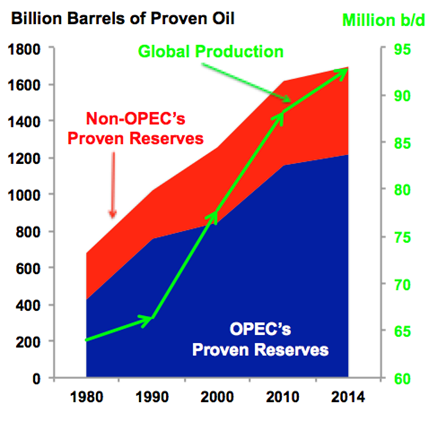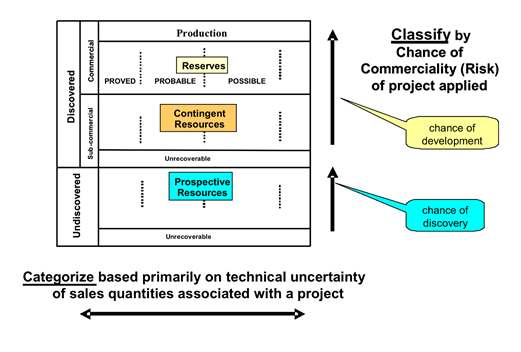Over the past a few decades, oil doomsayers have been claiming that we are running out of oil. In fact, many of them have attempted to predict when the global peak oil would occur. The first and most popular attempt was made by a famous geologist M. King Hubbert, who theoretically predicted the global oil production to peak in 1995. Unfortunately, his prediction was not correct and so did all other predictions. In fact, since the year Hubbert predicted global oil production would peak, oil production has increased by 33% to over 93.2 million barrel per day and it is expected to continue increasing by approximately 1 million b/d per year according to EIA and IEA.

Global Oil Reserves Growth, Source: BP, EIA
Although these attempts have failed in predicting the big rollover and how long oil will last, they succeeded in creating public misconceptions about the oil reserves. In general people think that there is no more oil to be discovered. They also think that the current published proved reserves statistics represent the amount of oil left, and once that oil is produced we will run out of oil. Therefore, this article is meant to highlight the reasons that led to such misconceptions and to provide the basics of oil reserves for a better understanding.
What Caused The Public Misconceptions?
The whole issue comes down to a simple statistic called “proved reserves” which is used in predicting the peak oil and how long oil will last. “Proved reserves” is defined as the amount of oil that can be recovered from the total oil-in-place given today’s economics and technology. By definition, “proved reserves” depends on two variables; economics and technology. These two variables are changing over time and expected to continue growing for the foreseeable future, and consequently proved reserves will also continue growing in the same manner.
This means tomorrow’s “proved reserves” will definitely be different from today’s. This is due to the fact that as technology advances and oil prices increase, the percentage of oil that can be recovered from the total oil-in-place increases which literally means higher proved reserves. Therefore any attempt to predict when oil production’s peak would occur or how long oil will last based on the present proved reserves will definitely lead to wrong conclusions.
To make it more clear, take for instance the total world proved oil reserves estimates published by BP in 2014 and 2015. In 2014, the company’s estimates for the world proved oil reserves reached 1,687.9 billion barrels, however, in 2015, BP raised its reserves estimates to 1700.1 billion barrels. If we were to predict when the peak oil will occur or how long oil will last using BP’s 2014 proved reserves estimates, our prediction would have been proved wrong just by the end of 2015, because proved reserves in 2015 have increased to 1700.1 billion barrels, which means that we will have a different peak oil timing and oil would last longer.
The above example gives us a clear answer why the experts are often wrong in their predictions. They falsely equate the present proved reserves with future production and underestimate the ability of the human mind to develop new technology and discover better methods of locating and extracting oil. Such misuse of the proved reserves estimates to declare when the peak oil would occur and the wide publicity these predictions received have resulted to such public misconceptions regarding oil reserves.
Besides that, another reason that has contributed in creating such public misconceptions regarding oil reserves is the misuse of proved reserves estimates by the media with less or no clarification on what it stands for. For instance, a few days ago while I was searching in the internet about the world oil reserves, I came across an article with a title; “The world has 53.3 years of oil left”. The Author used BP’s world proved oil reserves estimates for 2014 in a way that made it appear to be as it is all the oil that is left under the ground, however, that is totally wrong. There is a huge difference between proved reserves and the total oil-in-place which the public, media reporters and industry analysts should be aware of.
What You Should Know About Oil Reserves
It may surprise you to know that proved reserves estimates provided by BP, EIA or IEA -which many people think it is the oil that is left underground- are just a small portion of oil that exists underground. In fact no body knows how much oil exists under the earth’s surface. If you look at the figure below, you will notice that the oil underground is divided into two categories, discovered and undiscovered oil. The lower part represents the oil that is not yet discovered. This oil is considered as prospective resources and has a higher chance of discovery. The current deepwater resources, shale oil and tar sand were once undiscovered resources, as technology advanced, these types of resources became discovered resources. Therefore, it is expected that as more advanced technology become available, new prospective resources will be discovered.

Types of Oil Reserves, Source: Society of Petroleum Engineers
On the other hand, the upper part of the figure represents the oil that has been discovered. Discovered oil is classified by commerciality of the project into two types, commercial and sub-commercial oil. While sub-commercial oil represents contingent oil and oil that is unrecoverable, commercial oil represents both of the oil reserves and oil that has been produced. Oil reserves are categorized based on the availability of advanced extraction technology and oil prices into three categories; proved, probable and possible reserves.
It is in this area where you can find the portion of the oil reserves that is considered as proved reserves which many people falsely think it is the oil left underground. If you look at reserves in the figure, you will notice that a huge portion of the reserves is considered as probable and possible reserves. As oil companies have more knowledge and a better understanding of oil reservoirs accompanied by advanced technology and higher oil prices, more oil from both probable and possible reserves turn into proved reserves. This explains the continuous increase of proved reserves estimates. And the more it happens, the more proved reserves we have, and the longer oil last.
It should be clear by now that “proved reserves” is not the same as the oil left underground. “Proved reserves” is the mount of oil that can be recovered given today’s technology and economics and it is a small portion of the total oil-in-place. As technology and oil prices increase over time, proved reserves continue to grow and hence it not a useful statistic to predict the peak oil or time left before we run out of oil.
The public should understand that the real challenge we face today is not that we are running out of oil, rather how much oil can we recover. The current world average oil recovery rate is in the 30-35% bracket. If we are able to increase the recovery rate by a small percentage, we can recover billions of additional oil. We have a plenty of oil to be recovered as well as discovered, what we need is more knowledge, better reservoir understanding, more innovation and advanced technology.
This article originally appeared on Oil + Gas Monitor.

